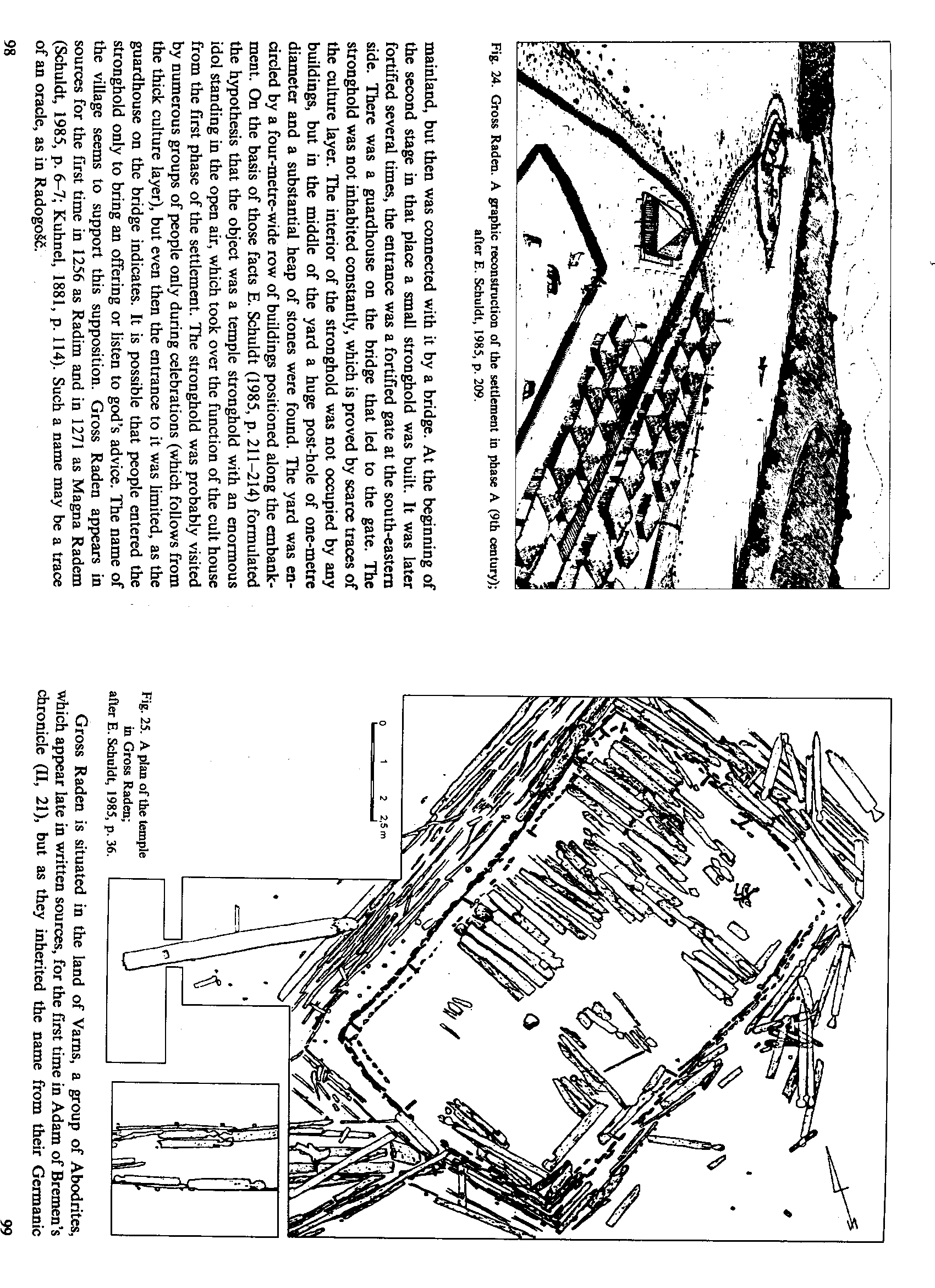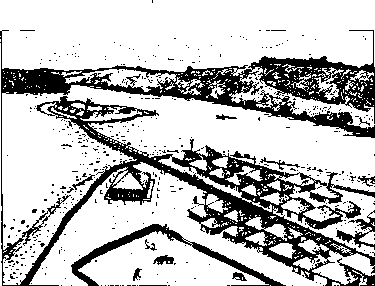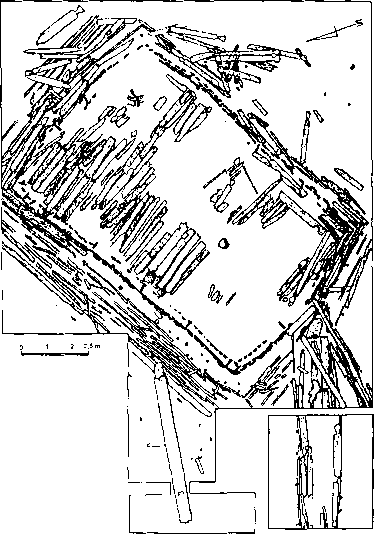image048


Fig. 24. Gross Raden. A graphic reconstruction of the settlement in phase A (9th century); after E. Schuldt, 1985, p. 209.
mainland, but then was connected with it by a bridge. At the beginning of the second stage in that place a smali stronghold was built. It was later fortifled several times, the entrance was a fortified gate at the south-eastern side. There was a guardhouse on the bridge that led to the gate. The stronghold was not inhabited constantly, which is proved by scarce traces of the culture layer. The interior of the stronghold was not occupied by any buildings, but in the middle of the yard a huge post-bole of one-metre diameter and a substantial heap of Stones were found. The yard was en-circled by a four-metre-wide row of buildings positioned along the embank-ment. On the basis of those facts E. Schuldt (1985, p. 211-214) formulated the hypothesis that the object was a tempie stronghold with an enormous idol standing in the open air, which took over the function of the cult house from the first phase of the settlement. The stronghold was probably visited by numerous groups of people only during celebrations (which follows from the thick culture layer), but even then the entrance to it was limited, as the guardhouse on the bridge indicates. It is possible that people entered the stronghold only to bring an offering or listen to god’s advice. The name of the village seems to support this supposition. Gross Raden appears in sources for the first time in 1256 as Radim and in 1271 as Magna Radem (Schuldt, 1985, p. 6-7; Kuhnel, 1881, p. 114). Such a name may be a tracę of an oracie, as in Radogośc.

Fig. 25. A plan of the tempie in Gross Raden; after E. Schuldt, 1985, p. 36.
Gross Raden is situated in the land of Vams, a group of Abodrites, which appear late in written sources, for the first time in Adam of Bremen’s chronicie (II, 21), but as they inherited the name from their Germanie
99
Wyszukiwarka
Podobne podstrony:
image008 Fig. 4. Possible reconstructions of the tempie in Old Uppsala, drawings based cm: A.-C. Sch
image018 Exterior septorum ordo Fig. 11. Niederle’s reconstruction of the tempie in Arcona based on
A reconstruction of the Marketplace in Hildesheim Badania nad zastosowaniem borowodorku sodu w konse
image053 Herrmann’s thesis about the cult Function of the settlement in Ralswiek, although the fuli
The history of the chancellery in XIX-XXth centuries I. WIEDZA Po ukończeniu studiów absolwent: 1.
image047 Fig. 22. The location of the stronghold in Gross Raden. 1 - the stronghold in Gross Grónow;
image049 1 m Fig. 26. The profile and plan of the remains of Ihe south-ea&tem wali base of the t
P1130005 Fig. 1.24: Intense echogenicily (arrows) at the site of the est-rous follicle one day after
image055 Fig. 39. Starigard (Oldenburg). The sanctuary erected after the destruction of the church i
Slajd56 Bielactwo Fig. 1.3-2.8 Bila te rai segmental vitiligo of the same distri>ution in Asian{a
Slajd56 Bielactwo Fig. 1.3-2.8 Bila te rai segmental vitiligo of the same distri>ution in Asian{a
103 RIKEN Accel. Próg. Rep. 24 (1990)111-5-9. Test Experiment of the GARIS/IGISOL K. Morita, T. Nomu
134RIKKN Accel. Próg. Rep. 24 (1990) Table 2. Output currents of the source. ECRIS (
10 Małgorzata Bednarczyk, Ewa Wszendybył-Skulska 5% of gross domestic product (GDP) of the European
RECONSTRACTION OF THE PIG COMPLEX ACCORDING TO THE EUROPEAN STANDARDS Project initiator Privately
image001 J I •JUDITH-MERRIL was one of the pioneers in the feminin© invasion of science fiction
więcej podobnych podstron